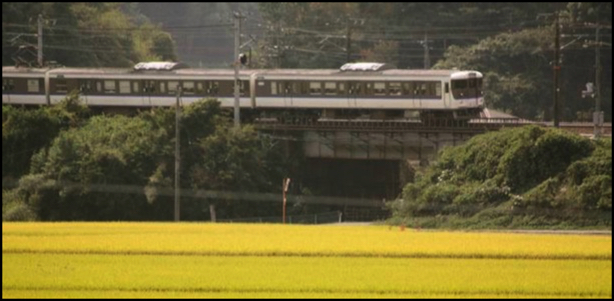Getting into Japanese Model Railroading
12 August 2010 22:38 Filed in: Model Trains

Note: an updated version of the Musing is now on the Getting Started with Japanese Model Trains page.
The photo above (from flickr) shows a typical Japanese electric multiple-unit passenger train (I think it’s a Series 115-2000 in the “Hiroshima Renewal” color scheme) running along an embankment above some rice paddys, with a heavily-wooded hillside in the background. Outside of the urban and suburban areas I prefer to model, this is a typical scene. And that’s one of the great things about modeling Japanese railways: whether you are interested in high-speed rail (bullet trains), short rural passenger trains rumbling through the woods, action-packed multi-track commuter trains, small trams slipping behind buildings or running down a busy street, or semi-rural passenger/freight railroading, there’s a prototype there to draw inspiration from. And thanks to the Internet, you can get photos (on flickr, search on “Japan Railway”, with over 13,000 images to start), maps (maps.google.com or Google Earth), video (on YouTube, search for “Japan Train” or similar phrases), and a fair amount of data (wikipedia), without ever leaving your chair.
And with a bit of experience you may find yourself reading Japanese fan blogs thanks to the magic of Google Translate’s one-click translation menubar add-on. Mind you, Google’s idea of translation leaves more than a bit to the imagination, “Of the DCC and DCC-friendly design is a standard method of KATO new products in recent years.” is one of the more legible sentences I’ve seen, probably better phrased as “In recent years, the ‘DCC-friendly’ design has been a standard method of KATO’s for new products.”. But it’s still something magical to be able to read a complex and very foreign language, however badly, at the click of a mouse. And the tools will only get better with time.
If you’re reading this site, and aren’t already modeling some kind of Japanese railway, you probably have an interest in, or at least some curiosity about, some aspect of Japan or Japanese railroading. And maybe you want to get into Japanese Model Railroading, but the sheer scope of it is a bit intimidating, or you just don’t know where to start. For information, I’ll recommend the Japanese Modeling & Japan Rail Enthusiast’s Forum (JNS Forum), and in particular their Prototype board, which is a great source of information and inspiration. They’re a warm and friendly group, and always willing to answer a new member’s questions.
For track, any old N-Scale track will do, although Kato’s Unitrack (which is readily available in most U.S. hobby stores stocking N-scale trains) is very robust and reliable, and easy to use for temporary table-top layouts if you’re short on space.
And for the trains themselves, if the thought of ordering specialized trains from overseas is a bit daunting, there are alternatives. Many local hobby stores that handle trains can order Japanese trains through the same supplier who provides Greenmax building kits (Mokei), and some may even have current or recent Kato and Tomix catalogs (they’re in Japanese, but they have great pictures, and model numbers for ordering). Those may list things presently out of stock, so it’s a bad idea to set your heart on one special model, but there’s stuff out there. And some domestic Internet hobby stores carry a selection of at least some models. For example, Model Train Stuff has a Kato N-Scale Japanese Prototype section with a number of Kato’s Shinkansen (bullet train), tram, and commuter/express trains in stock at present. Many stores are also carrying Kato’s Unitram urban light railway sets and trams (streetcars).
And it really isn’t that hard to order from Japan. Hobby Search recently started taking Paypal which can be used with any credit card (they also take credit cards directly, but that’s a bit more of a pain, and some banks like to charge extra for international handling). There’s also the Plaza Japan E-bay store, which is quite simple to use, although not as nicely indexed as Hobby Search.
So, if you aren’t too picky, you can get started with Japanese model railroading with a loop of track from your local hobby store, and a train from some place like Model Train Stuff or another online dealer. It’s easy, whether you’re new to model railroading, or an experienced modeler who wants to try something new and different.
The videos I linked above included the JR West Series 500 Shinkansen, the EIDEN 900, a JR East E231 Suburban commuter train (often available in the U.S., but presently only from Japan). Others are probably only available from Japan, and include an Enoshima Railway train, and the freight locomotive, which is is an EF65-1000, similar to this EF65-500 model. And while I think the photo at the top is a 115-2000 (no model available), it looks a lot like this 165 Series (in shape, if not in color). The links above were all in stock when this was written, although that’s subject to fairly rapid change.
In other website updates:
- My M250 Super Rail Cargo freight EMU arrived. It’s described on my Roster and Freight Train collection pages. This is a really cool express freight train, designed to run on the same line as regional passenger trains, and at the same (130 kph / 81 mph) speeds to avoid disrupting schedules.
- I’ve updated the Riverside Station Scene and “Phase 2i” construction pages with details of recent work.
- I added a bunch of photos and other information to my prototype page on Resort and Other Passenger Trains and created a Passenger Locomotives page.
- I’ve also done a bit of cleanup on some other pages, and added photos to the Station, Roster and Construction photo albums.
== Comments from old system:
Friday, August 13, 2010 - 10:29 AM
CaptOblivious
Thanks for the advertisement!




